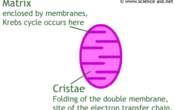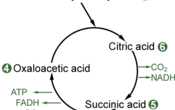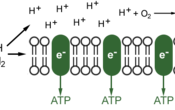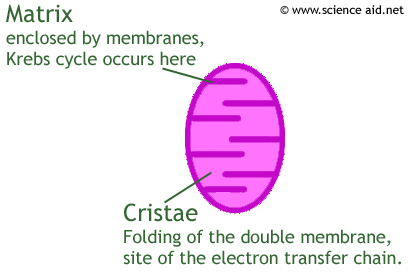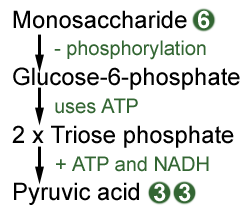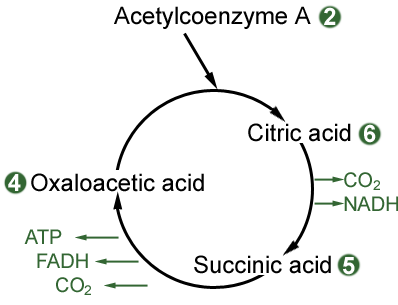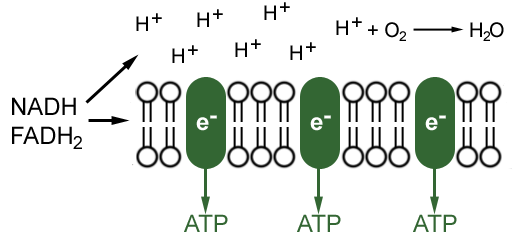Respiration: Glycolysis, Krebs Cycle, and Electron Transfer Chain
Edited by Jamie (ScienceAid Editor), Taylor (ScienceAid Editor), Sharingknowledge, Jen Moreau and 1 other
- 1 Mitochondrion
- 2 Glycolysis
- 3 Krebs Cycle
- 4 Electron Transfer Chain
-
5 Questions and Answers
- 5.1 What are the organic molecules in the citric cycle. And what is the enzyme that breaks down from glycolysis to the citric reporting period?
- 5.2 Cristae and matrix correct in the diagram? I thought that they were supposed to the other way around?
- 5.3 Glycolysis, the link reaction, the Krebs cycle, and the electron transport chain are all part of?
- 5.4 What is Glycolysis Kreb Cycle and Electron Transport chain?
- 6 Referencing this Article
- 7 Comments
Mitochondrion
Before we look at respiration, it is useful to study where respiration happens. Below is an annotated diagram of a mitochondrion: the mitochondria are important [organelles] in all cells.
Glycolysis
Glycolysis is a series of reactions that take place in the cell cytoplasm. It involves the oxidation of glucose into pyruvate (a 3 carbon compound), that produces (overall)ATP and reduced NAD: an enzyme that carries hydrogen. The number of carbons in each of these compounds is indicated in the green circle.
Now, the product: pyruvate (or pyruvic acid) is actively transported into the mitochondria where the link reaction occurs. Here, the pyruvate molecule combines with coenzyme A to form the 2 carbon acetylcoenzyme A. Producing carbon dioxide and hydrogen.
Krebs Cycle
Like the link reaction, the Krebs Cycle occurs in the matrix of the mitochondrion. The reaction is as follows:
The acetyl CoA from the link reaction combines with Oxaloacetic acid to form citric acid, this is then broken down to produce some ATP and reduced NAD and FAD (NADH and FADH).
The many hydrogen molecules carried by NAD and FAD are also used to produce ATP, by being taken to a further stage.
Electron Transfer Chain
This process takes place on the inner mitochondrial membrane which is folded to cristae. This provides a large surface area for the electron transfer chain to take place.
The carriers FAD and NAD bring the hydrogen and it separates to H+ and electrons (e-). The electrons pass from carrier to carrier and loose energy. This is used to synthesize ATP.
However, there are a lot of hydrogen ions, that unless they are removed, they'll cause a large increase in pH. Therefore, oxygen reacts with the ions to remove it and produce water. This is what the oxygen you inhale is used for (in terms of respiration).
Questions and Answers
What are the organic molecules in the citric cycle. And what is the enzyme that breaks down from glycolysis to the citric reporting period?
I have an exam tomorrow and would like a simple review of glycolysis cycle
Molecules in Citric Cycle
- NADH: An energy shuttle which delivers high-energy electrons to the electron transport chain where they will eventually power the production of 2 to 3 ATP molecules. When this electron shuttle is not carrying high energy electrons, meaning it has been oxidized (lost its electrons), it is left with a positive charge and is called NAD+
- FADH2: Another energy shuttle that carries high-energy electrons to the electron transport chain, where they will ultimately drive production of 1 to 2 ATP molecules. The oxidized form of FADH2 is FAD and happens just like in NADH.
High energy molecules: ATP: The basic energy currency of the cell. It's a form of energy that cells can use right away GTP: Similar to ATP, GTP can be easily converted to ATP in the cell.
Enzyme that breaks Pyruvates to Citric cycle Pyruvate, which is formed by the glycolytic catabolism of carbohydrates in the cytosol, after it enters mitochondrial matrix undergoes oxidative decarboxylation by a complex set of reactions catalyzed by a pyruvic dehydrogenase. The reactions catalyzed by pyruvic dehydrogenase require the participation of several coenzymes, including NAD+ and Coenzyme A.
Glycolysis Cycle Summary
Glycolysis occurs in the cytoplasm of the cell and is present in all living organisms. Glycolysis steps are broken down below
- In this process, glucose undergoes partial oxidation to form two molecules of pyruvic acid.
- In plants, this glucose is derived from sucrose, which is the end product of photosynthesis, or from storage carbohydrates.
- Sucrose is converted into glucose and fructose by the enzyme, invertase, and these two monosaccharides readily enter the glycolytic pathway.
- Glucose and fructose are phosphorylated to give rise to glucose-6- phosphate by the activity of the enzyme hexokinase. This phosphorylated form of glucose then isomerizes to produce fructose-6- phosphate. Subsequent steps of metabolism of glucose and fructose are same.
- In glycolysis, a chain of ten reactions, under the control of different enzymes, takes place to produce pyruvate from glucose.
- ATP is utilized in two steps: first in the conversion of glucose into glucose 6-phosphate and second in the conversion of fructose 6-phosphate to fructose 1, 6-bisphosphate.
- The fructose 1, 6-bisphosphate is split into dihydroxyacetone phosphate and 3-phosphoglyceraldehyde (PGAL). We find that there is one step where NADH + H+ is formed from NAD+; this is when 3-phosphoglyceraldehyde (PGAL) is converted to 1, 3-bisphosphoglycerate (BPGA). Two redox-equivalents are removed (in the form of two hydrogen atoms) from PGAL and transferred to a molecule of NAD+. PGAL is oxidized and with inorganic phosphate to get converted into BPGA.
- The conversion of BPGA to 3-phosphoglyceric acid (PGA), is also an energy yielding process; this energy is trapped by the formation of ATP. Another ATP is synthesized during the conversion of PEP to pyruvic acid.
- Pyruvic acid is then the key product of glycolysis.
- There are three major ways in which different cells handle pyruvic acid produced by glycolysis. These are lactic acid fermentation, alcoholic fermentation, and aerobic respiration. Fermentation takes place under anaerobic conditions in many prokaryotes and unicellular eukaryotes. For the complete oxidation of glucose to CO2 and H2O, however, organisms adopt Krebs' cycle which is also called as aerobic respiration. This requires O2.
Cristae and matrix correct in the diagram? I thought that they were supposed to the other way around?
Are the crust and the matrix labeled correctly in that diagram? I am very confused my diagrams have them labeled the other way around and now I do not know what is correct
ScienceAid QnA. This section is not written yet. Want to join in? Click EDIT to write this answer.
Glycolysis, the link reaction, the Krebs cycle, and the electron transport chain are all part of?
1. Photosynthesis. 2. Anaerobic Respiration . 3. Aerobic Respiration. 4. Fermentation. I didn't look at the information at all yet. Sorry!
ScienceAid QnA. This section is not written yet. Want to join in? Click EDIT to write this answer.
What is Glycolysis Kreb Cycle and Electron Transport chain?
I want to know everything to be known about them, the substrate level phosphorylation, oxidation phosphorylation and amount of ATP PYRUVATE and ADP produced in each of them
ScienceAid QnA. This section is not written yet. Want to join in? Click EDIT to write this answer.
Referencing this Article
If you need to reference this article in your work, you can copy-paste the following depending on your required format:
APA (American Psychological Association)
Respiration: Glycolysis, Krebs Cycle, and Electron Transfer Chain. (2017). In ScienceAid. Retrieved Apr 27, 2024, from https://scienceaid.net/biology/biochemistry/respiration.html
MLA (Modern Language Association) "Respiration: Glycolysis, Krebs Cycle, and Electron Transfer Chain." ScienceAid, scienceaid.net/biology/biochemistry/respiration.html Accessed 27 Apr 2024.
Chicago / Turabian ScienceAid.net. "Respiration: Glycolysis, Krebs Cycle, and Electron Transfer Chain." Accessed Apr 27, 2024. https://scienceaid.net/biology/biochemistry/respiration.html.
If you have problems with any of the steps in this article, please ask a question for more help, or post in the comments section below.
Comments
Article Info
Categories : Biochemistry
Recent edits by: Jen Moreau, Sharingknowledge, Taylor (ScienceAid Editor)
